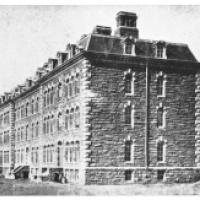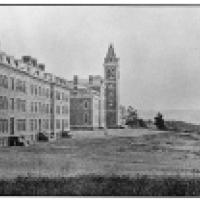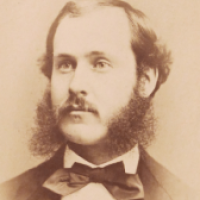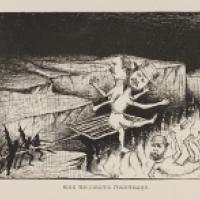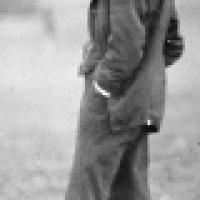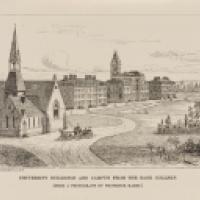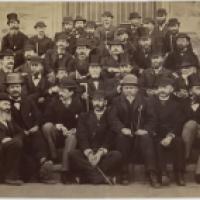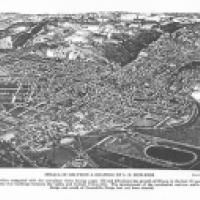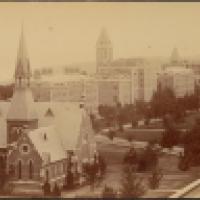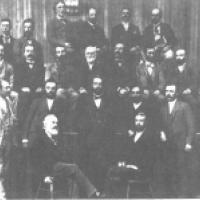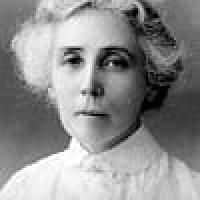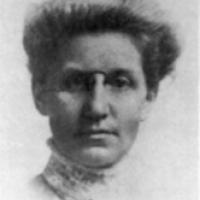Charter Day, April 27, 1865, and the The First Decade, 1868-1878
The Cornell University Charter was signed into law on April 27, 1865. For the next three years, Ezra Cornell and Andrew Dickson White worked tirelessly towards the opening of the university, which took place in the fall of 1868. (The picture on the right is from 1868.) Andrew Dickson White studied at Geneva College (now, Hobart and William Smith Colleges) before transferring to Yale in 1850 and graduating in 1853. After traveling to Europe (Paris, Moscow, Berlin), he returned to Yale, earned an M.A. in history in 1856, and taught history at Michigan University from 1857 to 1860. After collaborating with Ezra Cornell in the New York State Senate to create the new university, he was elected the first President of Cornell on November 21, 1866. One of his first and most important tasks was to select the faculty of the new institution.
As Ezra Cornell and Andrew White were collaborating to build Cornell University, higher education in the United States was still very far behind its European counterpart: Harvard celebrated its bicentennial in 1836, but its graduate school was only created around 1870; Yale’s Graduate School of Arts and Sciences and the Sheffield Scientific School were created in 1847, and Yale awarded the first U.S. Ph.D. (in any subject) in 1861; the first Doctorate of Medicine in the United States was conferred by Columbia University (King’s College) in 1870. The first American university dedicated to research and graduate education, Johns Hopkins University, was created in 1876, eleven years after Cornell’s official creation in 1865. For a variety of reasons, including religious beliefs and British influence, the study of mathematics in the United States was even further behind than the study of other subjects.
A very early picture of White Hall. White Hall (Building 2 or the North building) was still in construction at the opening of Cornell in 1868. It opened in 1869.
The first Ph.D. in mathematics granted by an American university was awarded by Yale to John Hunter Worrall in 1862. Also in 1862, William Watson received the first Ph.D. in mathematics (Jena) awarded to an American in Europe. Harvard’s first mathematics Ph.D. went to William Elwood Byerly in 1873. Upon graduating, Byerly took an assistant professorship at Cornell where he stayed for 3 years before returning to Harvard for the rest of his career. He is best known for his impact on Harvard's mathematics curriculum and his calculus books. Bylerly is said to have been deeply influenced by Cornell professor E.W. Evans.
At a meeting of the trustees in February 1867, White proposed to elect the first two Cornell professors, William Channing Russel in the Departments of Modern Languages and History and Evan Wilhelm Evans in the Department. Evans was born in Swansea, South Wales, on January 6, 1827, and his family emigrated in 1833, settling in Bradford, Pennsylvania. He graduated from Yale with high honors (A.B. 1851, M.A. 1854) and served there as tutor in 1855-56. Before joining Cornell, Evans was Professor of Natural Philosophy and Astronomy at Marietta College.
In the opening year, 1868, 412 students enrolled at Cornell. was taught by Professor Evans and Assistant Professor Ziba Hazard Potter, who had served as a surgeon during the Civil War and was in charge of the hospital at Fort Randall in the Dakota Territory until 1867. Only Cascadilla Hall and the south building (Morrill Hall) were finished. The north building (White Hall) was still under construction.
McGraw Hall construction began in 1869 and was finished in 1872. The building was the gift of John McGraw. It was built to accommodate the library and the collection of natural history as well as instruction rooms. Note that Morill, White and McGraw where built with their main facade facing outward toward the slope, not towards the present Arts Quad. See the picture and drawing above.
The second year, Evans and Potter were joined by three more men, the most notable of which was Henry Turner Eddy, a graduate from Yale (A. B.1867, Sheffield Scientific School Ph.B. 1868). Eddy received a degree in Civil Engineering in 1870 and a Ph.D. in Applied in 1872, the first Ph.D. awarded by Cornell University. Eddy left Cornell in 1873. After a year as adjunct professor at Princeton, he became Chair of the Department of at the newly created University of Cincinnati where he later served as President. In 1891, he became President of the Rose Polytechnic Institute. In 1894, he moved to the University of Minnesota, retiring in 1912 after serving as Dean of the Graduate School. Eddy Hall on University of Minnesota’s Old Campus is named after him. (Eddy Street in Ithaca's Collegetown is not named after H.T. Eddy. It is named after Otis Eddy, the man who owned a cotton mill on Cascadilla Creek and employed Ezra Cornell as a mechanic when Cornell first arrived in Ithaca.)
Three other professors formed the core mathematics faculty at Cornell in these early years. Lucien August Wait joined Cornell in 1870, James Edward Oliver arrived in 1871, and George William Jones in 1877. Like White and Evans, Jones was a Yale graduate (A. B. 1859, M.A. 1862). Before coming to Cornell, he was Professor at Iowa State Agricultural College from 1869 to 1877. Wait and Oliver had graduated from Harvard in 1970 and 1849, respectively. None of these men had a doctorate. Jones became Professor Emeritus at his retirement in 1907 (both Evans and Oliver passed away while serving as Chair). Wait retired and became Professor Emeritus in 1910.
The drawing is from an early Cornell yearbook. The two-headed professor seated on the grill represents Professors Wait (in profile, on the left) and Jones (facing us, on the right). The man falling appears to be physics professor William A. Anthony, one of the first to introduce and teach electrical engineering. A picture of Wait is included below. Jones and Anthony appear in the 1882 picture of the entire faculty also provided below. Despite appearing in this student's nightmare, all three men had excellent reputations as teachers!
In Europe, the first half of the nineteenth century saw tremendous progress in mathematics with the work of Gauss, Cauchy and Riemann, to cite just a few of many remarkable contributors. In the United States, Benjamin Peirce, Professor at Harvard from 1831 until his death in 1880, is widely considered the most influential of the very few American mathematicians of that period. Although Peirce graduated from Harvard, his mathematical education was greatly influenced by Nathaniel Bowditch. Bowditch, a self-taught mathematician, dropped out of school at age ten. He is famous for his English translation of Pierre-Simon de Laplace's Mécanique Celeste.
James Edward Oliver was born in Portland, Maine, on July 27, 1829. In 1846, at the age of seventeen, he entered Harvard College, passing into the sophomore class. There he became a student of Benjamin Peirce, who appeared to have held Oliver in high esteem. After graduating from Harvard in 1849 and upon Peirce recommendation, Oliver joined the newly established Nautical Almanac Office where Peirce had great influence. Oliver dreaded the work at the Nautical Almanac Office but stayed for over fifteen years. He left when the Almanac Office moved from Cambridge to Washington. After spending time in New York, Philadelphia and teaching a Thermodynamic course at Harvard, he accepted an assistant professorship at Cornell and moved to Ithaca in the fall of 1871. He was elected a fellow of the American Academy of Arts and Sciences (before joining Cornell) and a member of the National Academy of Sciences in 1872, shortly after joining the department. The next year, he was promoted to the rank of full Professor. He chaired the department from 1874 to his death in 1895.
Lucien Wait was also a student of Peirce at Harvard. Wait was an effective administrator and served as Associate Chair for most of Oliver's tenure. Upon Oliver’s death in 1895, he became the third Chair of the Department. In Ithaca, Wait is remembered as one of the two young Cornell professors who founded the Cascadilla School. Wait Avenue, which forms a crescent off Thurston Avenue, is named after him.
Jones, Oliver and Wait appear to have formed a very complementary trio. Oliver had vision and mathematical talent, Wait was an excellent teacher and good administrator and Jones was a great drill master. Known as Piute Jones for his perceived resemblance to a Piute Native American, he ran the Piute Jones's summer school which was dedicated to coaching sub-freshmen for the University Scholarship examinations. The three men co-authored successful and innovative university text books.
The first decade of the university was a trying time but also a time of great enthusiasm. Everything had to be built and organized, from the water system to the curriculum of the new university. Cornell University grew out of an ambitious vision including several revolutionary ideas. It was to be a non-sectarian institution where "any person can find instruction in any study". In 1870, the first women was admitted. Starting in 1872, women were admitted on a regular basis. Students were given great liberty to follow their own curriculum via electives. This, in turn, played a great role in the development of advanced courses, graduate education and scholarly research.
By 1878, Cornell was under attack on three fronts: its non-sectarian stance, coeducational status, and its novel curriculum. Ezra Cornell passed away in 1874 and Andrew White was in Europe. Vice President Russel served as Acting President and Henry Sage was leading the Board of Trustees. For several years, the financial situation was difficult and annual enrollments were dwindling, reaching an all time low of 384 in 1881-82. Between 1879 and 1881 the Trustees, worried for the future of the institution, discussed purging the faculty of its most liberal elements. In the mathematics department, James Oliver and George Jones were targeted for their views and public stances on various social issues. In the end, in 1881, President White came back from his long absence in Europe and, fortunately for the mathematics department, only Vice President Russel lost his job (this important event played a role in the emergence of the notion of tenure at American universities.)
It appears that the mathematics faculty were strong supporters, not only of the non-sectarian nature of the institution but also of coeducation and of the new curriculum. In his autobiography, White notes with amusement that he received strong support for the introduction of courses covering modern literature from an unlikely source, the mathematics department, especially Professor Evans and Oliver, which he calls the best writers on the faculty. Indeed, Evans was know as a superb Cymric literature scholar and Oliver was his class poet at Harvard! More importantly perhaps, the mathematics faculty would, in time, develop elective courses and create a research department supporting a strong graduate program. In 1883, students in the mathematics department could take courses on quaternions and on imaginary and elliptic functions.
We close this first chapter of the life of the department by looking at the few first students who showed interest in mathematics. Pictured left, Arthur S. Hathaway in later years at Rose Polytechnics.
- John Manly Chase BS 1872, Clergyman and teacher, professor of mathematics at Mills College and Seminary.
- Oliver Hazzard Perry Cornell CE 1870, Instructor of at Cornell 1870-71, Railroad Engineer. He was the youngest son of Ezra Cornell.
- Edward Wyllys Hyde BCE 1872, CE 74, Professor of and later, President, University of Cincinnati.
- George Tayloe Winston, Lit.B 1874, Instructor of , Cornell 1874-75, later President of The University of North Carolina, The University of Texas, Austin, and North Carolina College of Agriculture and Mechanical Arts, now North Carolina State University.
- Charles Ambrose van Velzer BS 1876, Fellow in , The Johns Hopkins University 78-81, Professor and Chair of , University of Wisconsin.
- Lenna Lillian Hill (later, Severance) BS-L 1879, Teacher of and History from 1879 to 1885.
- Arthur Stafford Hathaway, BS (Math), 1879, Fellow in , The Johns Hopkins University 1882-84, Assistant Professor, Cornell 1884-1891, Professor and Chair of , Rose Polytechnic Institute. Hathaway was a talented mathematician. He and E.W. Hyde are the only students on this list who later published mathematical research articles.
Of these students, van Velzer is probably the first mathematician who graduated from Cornell. At the University of Wisconsin, he supervised the first two mathematics Ph.D.s of this institution. Arthur Hathaway is the first to graduate with an explicit mention of mathematics. The articles he published while working with J. Sylvester at Johns Hopkins indicates he was an excellent mathematician. A year after moving to Baltimore, he lost is wife --Susan Hoxie, who was a Cornell student and the first women enrolled in the agricultural school-- and his son in childbirth. His son was named Edward Oliver Hathaway.
The Creation of the Graduate Program 1878-1888
After President White's return from Europe in 1881, various factors contributed to the improvement of the overall climate at Cornell. Enrollments started to grow again and reached 573 in 1884-85. On June 20 1883, the Board of Trustees passed a resolution renaming the south and north buildings as Morrill Hall and White Hall, respectively. In December 1884, the Board of Trustees assigned "room Q" in White Hall to the Department.
On Tuesday, July 8, 1884, The Daily Democrat announced the arrival of a new Instructor in mathematics at the Cornell University: Mr. James McMahon, who has been in Ithaca for the last year and a half, and has aided the mathematical faculty of the University in the preparation of their new algebra soon to be published, has been appointed instructor in mathematics for the coming year. Mr. McMahon is a graduate of Trinity College, Dublin, of the class of '81. He ranked among the first members of his class in mathematics and metaphysics throughout the course, and took highest honors in those subjects at graduation, securing the Wray and Brooke prizes. Mr. McMahon has also been instructor in logic in the Correspondence University since its organization. McMahon, certainly the best educated member of the department at the time, would become a pillar of the department until his retirement in 1922.
One of the key developments of this period is the beginning of the graduate program which is best illustrated by the following list of students.
- Hiram John Messenger Lit.B 1880, Fellow in 1885,86, Ph.D., 1886. Messenger is the first graduate student to obtain a Ph.D. in and the first such Ph.D. since H.T. Eddy in 1872. He is also the first Ph.D. supervised by James Oliver .
- Abram Rogers Bulllis BS (Math) 1881. Bullis is only the third Cornell student to graduate with a science bachelor in mathematics. The A.R. Bullis Chair in is named after him.
- George Henry Johnson received a BS at Rutgers in 1882 and a Master at Cornell in 1883. He returned at Rutgers where he earned a CE in 1885 and enrolled at Harvard where he received a Doctorate of Science in in 1887.
- Arthur Rollin Harris Ph.B. 1885, Fellow in 1886-87, Ph.D. 1888. In 1885, Harris graduated with Honors for General Excellence and Special Honors in with a dissertation titled "The Theory of Projectiles in a Resisting Medium". His Ph.D. memoir was titled "The Theory of Images in the Representation of Functions". He became one of the world experts on tidal theory. It seems likely that Harris was a student of J. McMahon who spoke about Harris' work on tidal theory and harmonic functions in his address to the Fifty-First Meeting of The American Association for the Advancement of Science, Pittsburgh, 1902.
- Edward Daniel Wightman BS (Math) 1886. Wightman received a Master in 1889 with a memoir titled "A Study of Certain Periodic Functions by their Addition Formula". He taught mathematics in Eden, NY.
- George Egbert Fisher BA 1887. Fisher obtained his Ph.D. in at the University of Pennsylvania where he served as Professor of , Chair and Dean of the College.
- Cadwallader Edwards Linthicum AB Yale 1880, Fellow in 1887-88, Ph.D. 1888. Linthicum is the first student to join the graduate program after attending another institution.
- Mary Anna Widman Ph.B. 1888, with a memoir titled "The Projective Treatment of Conics". Fellow elect in 1988. Teacher at Ithaca High School and later Librarian at Brown University. .
In his detailed and lively book, The Teaching and History of in the United, Florian Cajori writes If we compare Oliver, Wait and Jones’ Algebra with algebras used in our colleges ten or fifteen years ago, we discover most radical differences and evidences of a speedy awakening of mathematical life among us. A great shaking has taken place among the ‘dry bones’ of American mathematical text books, and no men ‘shake’ more vigorously than the professors at Cornell… At Cornell great efforts are made to teach the logic of mathematics, but it is hard to attain the desired standard on account of the way that preparatory schools train their pupils. The preliminary training in algebra generally gives students the idea that algebra is merely a mass of rules, and that students have simply to learn the art of applying them. In consequence, there is constant rebellion among average Freshmen to the logical study of algebra…. The attendance of students has been very large at Cornell. Compared with some other departments of the university, the teaching force in mathematics has been rather small. In consequence of this, the time and energy of the professors have been taxed unusually by work in the class room.
Cajori goes on to cite remarks made by Oliver in his 1886-87 annual report to the president: We are not unmindful of the fact that by publishing more, we could strengthen the university, and that we ought to do so if it were possible. Indeed, every one of us five is now preparing work for publication or expects to be doing so this summer , but such work progresses very slowly because the more immediate duties of each day leave us so little of that freshness without which good theoretical work can not be done… The greatest hindrance to the success of the department, especially in the higher kinds of work, lies, as we think, in the excessive amount of teaching required of each teacher; commonly from seventeen to twenty hours per week. The department teaches more men, if we take account of the number of hours’ instruction given to each, than does any other department in the university. Could each teacher’s necessary work be diminished in quantity, we are confident that the difference would be more than made up in quality and increased attractiveness.
By all accounts, Oliver was a brilliant man and a talented mathematician although his training was very limited by comparison to European mathematicians of his time. He is said to have been a quiet humble man who practised mostly for his own enjoyment and that of his students and was not motivated by publication and fame. Most remarkably, Oliver appeared to have had a clear vision of both the weakness of in the United States of his time and of its extraordinary potential.
In 1874, the astronomer Simon Newcomb commented on mathematical research in the United States as follows: the prospect of mathematics is about as discouraging as the retrospect and suggested one should contemplate the past with humility and the future with despair. In this context, Oliver understood that contacts with Europe were to be one of the keys in the development of departments of mathematics in the US. In 1876, the Johns Hopkins University was created. From 1877 to 1883, J.J. Sylvester became the leading mathematicians on American soil and attracted potential graduate students in to John Hopkins. After Sylvester left for Oxford, Oliver saw an opportunity for Cornell to fill the void and develop its graduate program. In the same annual report quoted above, Oliver write: yet one of our number, whose experience as a student, and as a teacher, enables him to judge, assures us that, now that Professor Sylvester has gone back to England, the opportunities offered here to the average student of the higher pure mathematics are quite as good as those at any other university in the country.
Ithaca, Göttingen and F. Klein 1888-1895
This important decade is marked by several landmark events in American in general and at Cornell in particular.
In 1888, the New York Mathematical Society was created. It would become the American Mathematical Society in 1894. Among the 16 members listed in1889, Cornell is represented by its recent Ph.D., John Hiram Messenger. On June 1st 1891, members include A.R. Bullis, H.T. Eddy, C.S. Fowler, A.S. Hathaway, G.W. Jones, J. McMahon, H.J. Messenger, J.E. Oliver and C.A. Van Velzer, all former Cornell graduates or Cornell faculty at the time.
Clark University was created in 1887 with a focus on graduate education. Its Department of was headed by William Story joined by Oskar Bolza, Henry White and Henry Taber. Story obtained is Ph.D. in 1875 in Leipzig, Bolza and White were students of Felix Klein. Taber received his Ph.D. at Johns Hopkins under Story.
In 1890 and 1891, William Osgood and Maxime Bôcher, former Harvard undergraduates returning from studies in Europe, assumed faculty positions at their Alma Mater. In Europe, supported by fellowships awarded by Harvard, Osgood and Bôcher attended Klein’s lectures in Göttingen. Osgood received his Ph.D. under Max Noether in Erlangen. Bôcher received his Ph.D. under Klein in Göttingen. At Harvard, they joined the triumvirate of William Byerly, James Mills Peirce, one of Benjamin Peirce’s sons, and Benjamin Osgood Peirce, a cousin of B. Peirce. Byerly and the two Peirces had their focus on the teaching of mathematics. Bôcher and Osgood, with their German training and fresh Ph.D. degrees, were determined to contribute to the progress of mathematical research.
The University of Chicago opened in 1892 with Eliakim Hastings Moore as Chair of and two German émigrés, Oskar Bolza and Heinrich Maschke as Professors of . After studying at various German universities, Bolza and Maschke had received their doctorates in Göttingen, Maschke in 1880 and Bolza in 1886. They were part of Klein’s circle and were good friends. When Bolza was offered a position at Chicago, he insisted that Moore offers a position to Maschke who, at the time, had moved to the United States to pursue a career as an electrical engineer.
In 1893, the International Mathematical Congress convened in Chicago as part of the World’s Columbian Exposition and with the participation of Felix Klein. Cornell’s first Ph.D., H.T. Eddy lectured on “Modern Graphical Methods”.
On this picture taken at the Chicago Congress, Oliver is seating on the left, Klein stands in the middle. Eddy is fifth from left on the third row from bottom. James McMahon is seventh from the left on the same row.
In 1889, James Oliver traveled to Europe with his wife (long a bachelor, he had married Sarah T. Van Petten the year before) to learn about at European Universities. Oliver’s plan was to visit Cayley in Cambridge but Cayley was frail and Oliver shortened his stay at Cambridge and went to Göttingen to visit Klein. Oliver stayed a year in Göttingen and Oliver and Klein became friends. Oliver wrote from Göttingen My work here is likely to be of great service to me, including the trains of thought and plans it suggests, no very radically new plans, only as to the spirit, the aims, and the details of my Cornell work. Indeed, Oliver's visit had an immediate impact on the development of the Department of at Cornell. On Saturday January 14 1891, the first meeting of the “Cornell Mathematical Club”, the precursor of today’s Oliver Club, took place. Among the graduate students attending the first Club were John Henry Tanner, Paul Saurel and Virgil Snyder. Two of them would soon visit Klein in Göttingen. In 1893, after the end of the Mathematical Congress in Chicago, Klein toured several American universities. He came to Ithaca and paid a visit to his friend Oliver.
Paul Saurel served as the secretary of the Cornell Mathematical Club during the first few years. He received a B.S. from the College of the City of New York in 1890 and joined Cornell that fall as a graduate student. He was a University Fellow in 1891-92 and an instructor between 1892 and 1896. In 1897, he returned to the College of the City of New York as an Instructor. He received a Science Doctorate from the University of Bordeaux in 1900, "Sur l’equilibre des systemes chimiques", supervised by Pierre Duhem, a French theoretical physicist and early admirer of Gibbs’ thermodynamics theory. Saurel spent the rest of his career at the College of the City of New York, serving as Chair for many years before he passed away in 1934.
Virgil Snyder (far left) came to Cornell to pursue graduate studies in mathematics after graduating from Iowa State College in 1890. Supported by a Brooks Fellowship from Cornell, he left Ithaca in 1892 to study under Klein in Göttingen. He received his Ph.D. “Ueber die Lineare Complexe der Lie’schen Kugelgeometrie” in 1895 and returned to Ithaca to become the most preeminent faculty of the department until his retirement in 1938.
John Henry Tanner (left) received his Bachelor from Cornell in 1891 and was immediately hired as an instructor in . He was promoted to Assistant professor in 1894 and traveled to Europe to study under Klein at Göttingen. He was also given a very special mission: to persuade a young German mathematician to take a position of Assistant Professor at Cornell. By the spring of 1895, he had convinced Klein’s closest student and associate at the time, Ernst Ritter, to accept the position. Ritter was appointed at Cornell. But, in a dreadful turn of events, he died from typhoid fever at Ellis Island upon arriving in the United States.
Ernst Ritter, The Lost Cornell Mathematician, January 9, 1867—September 23, 1895
On May 20, 1895, only a month after James Oliver untimely death at the age of sixty six on March 27, the New York Times published an announcement titled “Cornell’s New Professor – Mr Ersnt Ritter, Ph.D. Chosen Assistant in ”. From the New York Times article, we learn that Ernst Ritter was born at Walterhausern, Germany, went to school in Gotha and entered the university in Jena where he studied mathematics under Carl Johannes Thomae. After two years in Jena, he went to Göttingen where he studied under Felix Klein and Karl Hermann Schwarz. He spend two years training for the high school teacher profession, continuing to work under Felix Klein and, in 1891, was awarded his doctorate, suma cum laude. The New York Times article notes that the suma cum laude grade was rarely given by the Göttingen faculty. After receiving his doctorate, Ritter had become Klein assistant at Göttingen (Privatdozen) and, during the academic year 1894-1895, was lecturing on the theory of functions and geometry. The article concludes that Ritter’s coming to Cornell is a notable accession to the ranks of American mathematical scholars.
During the summer of 1895, Ritter sailed to America, fell ill during the crossing of the Atlantic and died at Ellis Island of a typhus attack (or, perhaps, typhoid fever) on September 23, 1895. He never reached Ithaca.
To understand the significance of this tragedy, we need to put it in the context of the time. The department of mathematics was led by Professor Lucien Wait (Chair, after the death of Oliver) and Georges W. Jones, together with Assistant Professors James McMahon and John Henry Tanner. None of these men had a doctorate. They were assisted by five instructors, James Allen, Charles S. Fowler, John I. Hutchinson, David A. Murray and Paul Louis Saurel. These instructors were graduate students except for D.A Murray who had received a Ph.D. at John Hopkins in 1893. In the entire United States, only a handful of mathematicians had an education that could remotely be compared with that of Ernst Ritter. Ritter’s mathematical published work consists of 6 papers that appeared in Mathematische Annalen between 1892 and 1896. The earliest work was discussed by F. Klein in his famous Evanston Lectures. Some of Ritter’s ideas were later used and expanded upon in the book “Vorlesungen über die Theorie der automorphen Functionen” by R. Fricke and F. Klein.
Here is the list of Ritter’s published works.
- Ueber die hypergeometrische Function mit einem Nebenpunkt. Math. Ann. 48 (1896), no. 1-2, 1–36.
- Ueber Riemann'sche Formenschaaren auf einem beliebigen algebraischen Gebilde. Math. Ann. 47 (1896), no. 2-3, 157–221.
- Die Stetigkeit der automorphen Functionen bei stetiger Abänderung des Fundamentalbereichs. Math. Ann. 46 (1895), no. 2, 200–248.
- Die Stetigkeit der automorphen Functionen bei stetiger Abänderung des Fundamentalbereichs. Math. Ann. 45 (1894), no. 4, 473–544.
- Die multiplicativen Formen auf algebraischem Gebilde beliebigen Geschlechtes mit Anwendung auf die Theorie der automorphen Formen. Math. Ann. 44 (1894), no. 2-3, 261–374.
- Die eindeutigen automorphen Formen vom Geschlecht Null, eine Revision und Erweiterung der Poincaré'schen Sätze. (German) Math. Ann. 41 (1892), no. 1, 1–82.
Ritter is best known for the first (almost) complete proof of the Riemann-Roch theorem and for introducing important extensions of that theorem. Read Ritter's obituary written by F. Klein and the remarks of Salomon Bochner
Between 1890 and his death in 1895, James Oliver supervised three more Cornell Ph.D.s, all of which were awarded to women.
Anna Helene Palmié received a Ph.B. from Cornell in 1890. She stayed at Cornell for a year as a graduate fellow in mathematics and later studied at the University of Chicago and at Göttingen (1898-1899). She spent her career as Professor of at Flora Stone Mather College, the women's college of Western Reserve University in Cleveland, Ohio, were she retired in 1928. She was a member of the AMS.
Ida Metcalf (left) received a Master from Cornell in 1889. In 1893, working under J. Oliver, she became the second American woman to receive a Ph.D. in . Her dissertation was titled "Geometric Duality in Space". She worked as a teacher and also as a security analyst until 1910 when she entered the civil service in the office of Controller of New York City.
Annie Louise McKinnon received her undergraduate degree at the University of Kansas and joined Cornell as a Fellow in in 1893. In 1894, she received her Ph.D., "Concomitant Binary Forms in Terms of the Roots", directed by J. Oliver. With the support of a fellowship from the Association of Collegiate Alumnae, she spent two years studying mathematics at Göttingen, attending F. Klein’s lectures. Upon her return, she became Professor of at Wells College before following her husband Edward Fitch, Professor of Greek at Hamilton College, who she had met at Göttingen.
In 1894, Estella Kate Wentz received her Master of Science with a memoir on "Definite Integrals". She was a member of the AMS and taught High School mathematics in Indianapolis until her retirement in 1931.
Agnes Sime Baxter received her undergraduate degree at Dalhousie University. She was a Fellow at Cornell in 1892-1894 and received her Ph.D., "On Abelian integrals, a resume of Neumann’s ‘Abelsche Integrele’ with comments and applications", in 1895 under J. Oliver. Following Oliver’s death in 1895, she edited his mathematical notes. She followed her husband, Albert Ross Hill, also a Dalhousie and Cornell graduate, in his academic career (he served as President of the University of Missouri). Among the first ten Ph.D. in awarded to American women, three were awarded at Cornell to Metcalf, McKinnon and Baxter.


